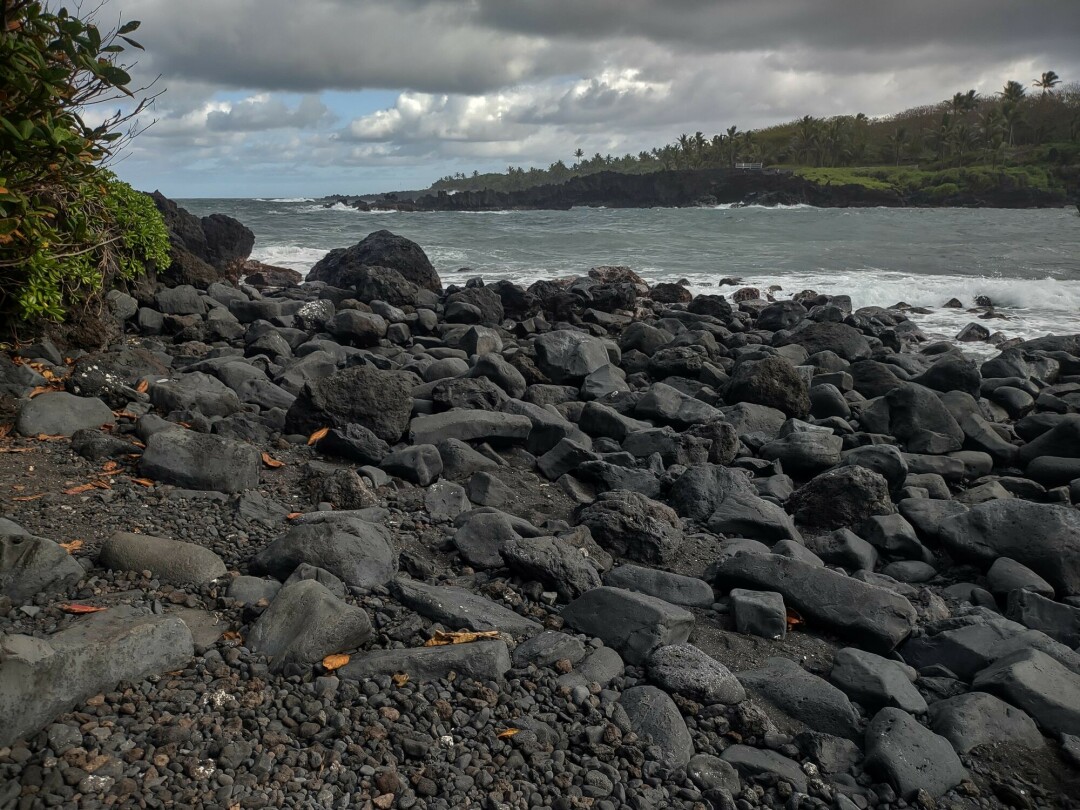News & Articles
Browse all content by date.

At Waiʻānapanapa State Park near Hana, Hawaii, the basalt on the beach and shoreline is very dark black and contains lots of air bubbles called vesicles. Photo by Emily Stone.
Cerulean waves crashed along the jagged black shoreline. The white foam matched happy little clouds in a blue sky. On the Big Island of Hawaii, my parents and I had been greeted by rain and flood warnings. Now, on Maui, there were blustery winds and high surf warnings. The ocean was impressive, especially where it pounded against the headlands of Ho'okipa Beach Park, on the way to the road to Hana.
Naturally, I scrambled down to get closer, remembering to never turn my back to the ocean. I’m a big fan of basalt bedrock shorelines. Basalt is the type of dark, igneous rock that forms when lava oozes out of volcanoes and cools quickly near the surface.
Hawaii is mostly built from basalt, but then, so is the North Shore of Lake Superior. Our North Shore basalts formed 1.1 billion years ago, as the Mid-Continent Rift began to stretch and thin and tear North America apart. Before the Adirondacks slammed into the proto-East Coast and stopped the rifting, we were on our way to becoming oceanfront property!
The rift lasted long enough for lava flows to accumulate an impressive amount of new rocks. Those rocks are now exposed along the North Shore of Lake Superior, the Upper Peninsula of Michigan and at waterfalls in Northern Wisconsin.
Hawaii is a different story. The lava there doesn’t erupt from a diverging rift zone. It forms because of a hotspot, where heated rock from the Earth’s core-mantle boundary rises up, melts the rocks above it, and then lava erupts in the middle of nowhere. Through time, the undersea volcanoes have built enough bedrock to rise above the ocean surface and become islands – islands that are still growing!
While the hotspot stays in one place, the ocean crust on top of it slides along, and so the volcanoes have built a chain of islands with the oldest ones to the north, and the youngest ones (Maui and the Big Island) to the south. Mauna Loa, which makes up most of the Big Island, rises 9 km above the seafloor, and is the tallest volcano on Earth. To find a bigger one, you’d have to go to Mars.
I’ve known the basic story of Hawaii since seventh grade, when I crafted a moving model using a shoebox, playdough and a baking soda/vinegar hotspot. And I’ve spent a lot of time playing on, teaching and learning about Mid-Continent Rift basalt since college. But by the time we’d driven all the way to Hana on the northeast corner of Maui, I was starting to have questions.
The black sand beach, craggy headlands and piles of boulders were so much blacker than the basalt around home. Why? From the few clues still preserved in North Shore rift basalts, we can guess that those lava flows were mostly the pāhoehoe type. These hot, slow-moving lava flows tend to have ropy surfaces. The root of the word come from the Hawaiian word “to paddle,” and probably refers to the ripples your paddle makes in the water.
There are pāhoehoe lava flows on Hawaii, too, but ‘a‘ā lava flows are more plentiful. These masses of lava flow so quickly that the surface shatters into jagged chunks that would make you say “Ah! Ah!” to walk across. ‘A‘ā surfaces are much less common in the Mid-continent Rift.
This didn’t seem like the full story, though, so I called up Tom Fitz, geology professor at Northland College, and learned that it has a lot to do with agates. Lake Superior Agates contain beautiful concentric bands of quartz, often stained red with iron. People hunt for them on the pebble beaches of Lake Superior, as well as in gravel pits and other glacial deposits in the area.
These beautiful rocks formed within the rift basalts. The rift area stayed volcanically active for roughly 23 million years, and in that time, rift basalts were deeply buried by more lava flows and eventually thick layers of sandstone. Hot water flowed through the buried rock, dissolving minerals and carrying them along. When the mineral-rich water encountered a cavity, it precipitated a layer of quartz. Flush after flush of liquid with slightly different trace minerals resulted in beautiful, banded agates.
When eons of erosion exposed the basalt, the agates popped out into the hands of persistent rockhounds. The cavities where agates form originated as gas bubbles in the molten lava, which are called vesicles. Hawaiian basalts have LOTS of vesicles! Everywhere I went the rocks looked dimpled or spongy, or like a super fluffy chocolate cake with lots of airspace.
Mid-Continent Rift basalts had vesicles, too, at least until they were filled with amygdules of agates, copper, and other minerals. They were also darker in color until that hot water moved through, rusted the iron minerals and turned the basalts dark brown. In fact, in the few locations where you find rift basalts that have unfilled vesicles, the rocks are much blacker and more similar to Hawaiian basalts.
The volcanoes of Hawaii were fun to visit, but I have to admit, I prefer my basalt super old with the possibility of agates.
Emily Stone’s award-winning second book, Natural Connections: Dreaming of an Elfin Skimmer, is available to purchase at www.cablemuseum.org/books and at your local independent bookstore, too. For more than 50 years, the Cable Natural History Museum has served to connect you to the Northwoods. Our exhibit: “The Northwoods ROCKS!” is open through mid-March. Our Winter/Spring Calendar of Events is ready for registration! Follow us on Facebook, Instagram, YouTube, and cablemuseum.org to see what we are up to.
| Tweet |


